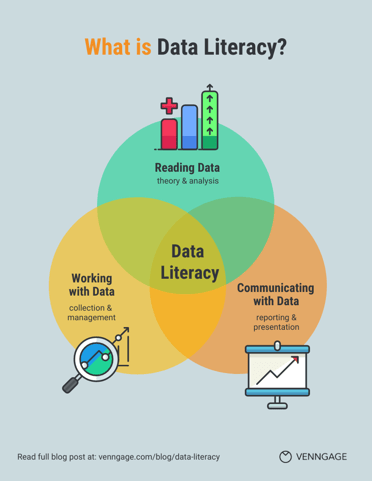
This stall manifests in several ways, including a differing maturity level between teams causing a divergence in technical approaches, an inability for data products to be consumed by certain teams and an inability for team members to meaningfully contribute to identifying, deploying and testing new approaches in their respective market.
It is then amplified while teams hunt for difficult to locate data, struggle to rationalize conflicting or unclear policies, and struggle with the challenges of tech debt and difficult or complex systems implementations. Each of these can be addressed through better awareness, more consistent communication and constant reinforcement of organizational norms and operating models.
Data literacy is about raising the bar for the entire organization as it relates to data awareness, consumption, creation and understanding. To avoid this stall in an organization, as new technology and capabilities are rolled out, an organization-wide investment needs to run parallel to raise the organization’s skills around data, platforms, products, visualization, and data science. Data literacy brings together the ability to formulate ideas, leverage data effectively to prove or disprove those ideas, and communicate outcomes and ideas to others.

There are a variety of approaches to take when building data literacy programs, which we’ll get into in future discussions. Today, we focus on the key questions that data literacy programs must answer to ensure employees are appropriately skilled and empowered to leverage data effectively. These questions can become modules of their own in a data literacy training curriculum or become consumable services for teams to leverage as part of workflows. The method of dissemination is less critical than the accessibility of the information and regular reinforcement across the organization.
-
What is our data strategy?
-
How does our data strategy align to our corporate objectives?
-
Where do I find data within our environment?
-
How do I publish data for others to consume?
-
What policies limit my use of data?
-
What technology should I use for the various stages of data preparation, visualization and analysis?
-
Under what circumstances can I use other technologies?
-
What forums are available internally for collaboration?
-
Where can I elevate business processes I have identified for improvement through data?
The more effectively team members can share data assets, discuss meaning of data trends and build new data driven applications, the more effectively an organization can deliver on their promise to customers. This effectiveness comes from a shared language and skill set enabling growth and maturity over time, while avoiding previous discussion topics, decisions, or “gut feelings” that aren’t quantified and measured.
Over time, building a data literacy program can enable your organization to more effectively collaborate, incrementally build new capabilities, measure outcomes, and onboard new team members.
I hope this post useful. Let me know if you have any questions in the comments, and don’t forget to sign up for the next post.
Share this
You May Also Like
These Related Stories

Building Organizational Models for Better Data Governance

Data: A Strategic Asset Beyond Data

No Comments Yet
Let us know what you think